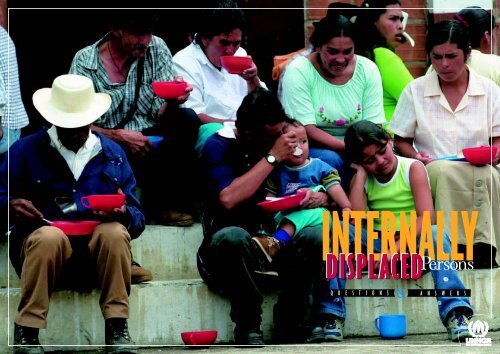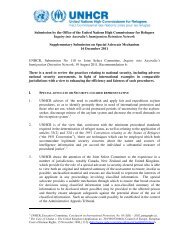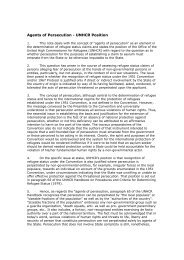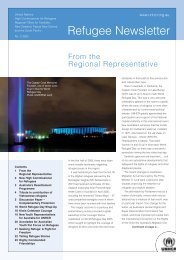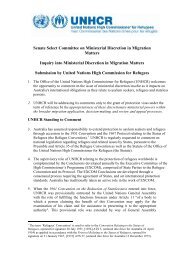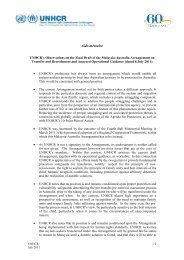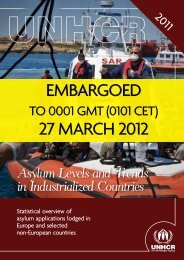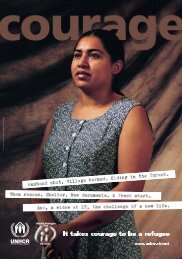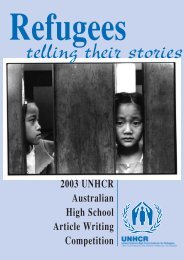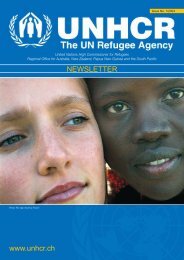Internally Displaced Persons - unhcr
Internally Displaced Persons - unhcr
Internally Displaced Persons - unhcr
Create successful ePaper yourself
Turn your PDF publications into a flip-book with our unique Google optimized e-Paper software.
INTERNALLY<br />
DISPLACED <strong>Persons</strong><br />
Q U E S T I O N S & A N S W E R S
PUBLISHED BY:<br />
UNHCR<br />
Media Relations and<br />
Public Information<br />
Service<br />
P.O. Box 2500<br />
1211 Geneva 2<br />
Switzerland<br />
www.<strong>unhcr</strong>.ch<br />
For information<br />
and inquiries,<br />
please contact:<br />
Media Relations and<br />
Public Information<br />
Service<br />
hqpi00@<strong>unhcr</strong>.ch<br />
A mother and<br />
child after<br />
fleeing their<br />
home in Sudan<br />
following an<br />
attack by<br />
government<br />
militias.<br />
Afghan women in the unusual role of helping to rebuild Afghanistan.<br />
P.BRONSTEIN/GETTY IMAGES/AFG<br />
UNHCR/ PI / Q&A IDPs / ENG1<br />
FEBRUARY 2004
INTERNALLY<br />
DISPLACED <strong>Persons</strong><br />
&<br />
Q U E S T I O N S A N S W E R S<br />
& ?<br />
QUESTIONS<br />
ANSWERS<br />
Cover:<br />
<strong>Displaced</strong><br />
peasants eat<br />
lunch in<br />
northwestern<br />
Colombia after<br />
being forced to<br />
flee because of<br />
fighting between<br />
opposing<br />
paramilitary<br />
forces.<br />
4 THE WORLD’S LARGEST GROUP OF<br />
VULNERABLE PEOPLE?<br />
6 WHO IS AN INTERNALLY DISPLACED<br />
PERSON?<br />
8 IDP WORLD MAP<br />
10 ARE REFUGEES AND IDPS TREATED<br />
DIFFERENTLY?<br />
AP/LUIS BENAVIDES/COL<br />
11 THE INTERNATIONAL COMMUNITY’S ROLE<br />
13 GUIDING PRINCIPLES<br />
13 UNHCR AND THE INTERNALLY DISPLACED<br />
14 HOW THE REFUGEE AGENCY RESPONDS<br />
OPERATIONALLY<br />
T. HICKS/GETTY IMAGES/SND<br />
INTERNALLY DISPLACED PERSONS • 2004<br />
3
UNHCR/S. HOPPER/DP/AGO•2003<br />
For decades they were largely ignored and<br />
forgotten, but together they comprise probably the world’s<br />
largest group of vulnerable people.<br />
Currently, there are an estimated 25 million of them, living<br />
amidst war, persecution and natural disaster, in at least 50 countries.<br />
They have little legal or physical protection and a very<br />
uncertain future—outcasts in their own countries.<br />
Bureaucratically, they are described as IDPs—internally displaced<br />
persons. In the real world, they are civilians, mostly<br />
women and children, who have been forced to abandon their<br />
4<br />
INTERNALLY DISPLACED PERSONS • 2004
& ?<br />
QUESTIONS<br />
ANSWERS<br />
homes because of conflict or persecution<br />
to seek safety elsewhere.<br />
When these displaced civilians<br />
cross an international frontier into a<br />
second state, they are generally<br />
afforded food and shelter by the host<br />
state, protected by international laws<br />
and legally classified as refugees.<br />
Others in similar circumstances<br />
but who, for whatever reason, remain<br />
in their own countries, become IDPs<br />
with few, if any, of the safeguards and<br />
assistance afforded refugees, under<br />
the ‘protection’ of often antagonistic<br />
governments or prey to rebel militias.<br />
Civilians<br />
preparing to<br />
return to their<br />
homes after<br />
decades of<br />
conflict in<br />
Angola.<br />
UNHCR’s mandate does not<br />
specifically cover IDPs. But because<br />
internally displaced civilians are<br />
often caught up in the same conflicts<br />
and face the same problems as<br />
refugees and because of the agency’s expertise, at the behest of<br />
the U.N. Secretary-General or other U.N. agencies, it does help<br />
some of these people, currently an estimated 5.8 million.<br />
In the last few years, the international community has begun<br />
to more vigorously debate major IDP issues—the question of the<br />
sanctity of state sovereignty versus human rights, how better to<br />
help these vulnerable people and what organizations should fulfill<br />
what roles.<br />
During that same period, the number of IDPs has remained<br />
relatively stable though there were major population movements,<br />
with millions of persons returning to their homes in<br />
Afghanistan, Sri Lanka, Angola and Bosnia, but similar numbers<br />
being displaced in Colombia, Côte d’Ivoire, Sudan and Africa’s<br />
Congo basin.<br />
INTERNALLY DISPLACED PERSONS • 2004<br />
5
& ?<br />
QUESTIONS<br />
ANSWERS<br />
UNHCR/S. GREENE/CS/SDN•1993<br />
Sudan probably has more<br />
internally displaced persons, at<br />
least four million, than any<br />
country in the world.<br />
B Who are the world’s<br />
internally displaced<br />
people?<br />
They are individuals or groups of people<br />
who have been forced to flee their<br />
homes to escape armed conflict, generalized<br />
violence, human rights abuses or natural or<br />
man-made disasters.<br />
6<br />
INTERNALLY DISPLACED PERSONS • 2004
UNHCR/M. KAMBER/DP/DRC•2003<br />
At least three million people have been killed and millions displaced in the Democratic Republic of Congo.<br />
B How many internally<br />
displaced persons are<br />
there?<br />
The Special Representative of the U.N.<br />
Secretary-General for <strong>Internally</strong><br />
<strong>Displaced</strong> <strong>Persons</strong> estimates there are as<br />
many as 25 million in 50 countries. Half of<br />
the overall total are in Africa. UNHCR cares<br />
for 5.8 million people from this group, in<br />
addition to some 10.4 million refugees.<br />
B How do IDPs differ from<br />
refugees?<br />
Both groups often leave their homes for<br />
similar reasons. Civilians become<br />
internationally recognized as ‘refugees’<br />
when they cross an international frontier to<br />
seek sanctuary in another country. The<br />
internally displaced, so-called IDPs, remain,<br />
for whatever reason, in their own states.<br />
INTERNALLY DISPLACED PERSONS • 2004<br />
7
& ?<br />
QUESTIONS<br />
ANSWERS<br />
GLOBAL<br />
POPULATIONS<br />
*Source: Global IDP Project, December 2003<br />
POPULATIONS OF<br />
CONCERN TO UNHCR<br />
[ DECEMBER 2003 ]<br />
Croatia z<br />
23,000<br />
FYR Macedonia z<br />
16,000<br />
Serbia-Montenegro z<br />
262,000<br />
Bosnia-Herzegovina z<br />
438,000<br />
334,000<br />
Colombia z<br />
950,000<br />
2,900,000<br />
Liberiae<br />
304,000<br />
500,000<br />
© ESA 1995. ORIGINAL DATA DISTRIBUTED BY EURIMAGES<br />
NOTE:<br />
There are an estimated 25<br />
million IDPs worldwide, the<br />
major concentrations<br />
highlighted by the red icons<br />
and figures. UNHCR cares<br />
for some 5.8 million of these<br />
people, the agency’s major<br />
operations indicated in blue.<br />
Côte d’Ivoiree<br />
100,000<br />
600,000<br />
Angola z<br />
202,000<br />
900,000<br />
D.R. Congo z<br />
9,000<br />
3,000,000<br />
0 - 100,000 100,000 - 300,000 300,000 - 600,000 600,000 - 1<br />
8<br />
INTERNALLY DISPLACED PERSONS • 2004
Georgia z<br />
262,000<br />
Russian Federationz<br />
431,000<br />
366,000<br />
Turkey z<br />
1,000,000<br />
Azerbaijan z<br />
577,000<br />
570,000<br />
Syriae<br />
500,000<br />
Afghanistan z<br />
1,419,000<br />
300,000<br />
Bangladesh z<br />
India z 520,000<br />
650,000<br />
Myanmar z<br />
1,000,000<br />
Sudan z<br />
4,000,000<br />
Uganda z<br />
1,200,000<br />
Burundi z<br />
100,000<br />
525,000<br />
Iraq z<br />
1,100,000<br />
Sri Lanka z<br />
683,000<br />
613,000<br />
Indonesia z<br />
600,000<br />
million 1 million - 1.5 million 1.5 million - 3 million more than 3 million<br />
INTERNALLY DISPLACED PERSONS • 2004<br />
9
& ?<br />
QUESTIONS<br />
ANSWERS<br />
UNHCR/A. HOLLMANN/CS/RUS•1999<br />
Children in Georgia attend psychosocial rehabilitation classes after being<br />
uprooted from their homes for years.<br />
B How are the two groups<br />
treated?<br />
Newly arrived refugees normally receive<br />
food, shelter and a place of safety<br />
from the host country. They are protected<br />
by a well-defined body of international<br />
laws and conventions. The U.N. refugee<br />
agency and other humanitarian<br />
organizations work within this legal<br />
framework to help refugees restart their<br />
lives in a new state or eventually return<br />
home.<br />
B And IDPs?<br />
<strong>Internally</strong> displaced persons often face a<br />
far more difficult future. They may be<br />
trapped in an ongoing internal conflict. The<br />
domestic government, which may view the<br />
uprooted people as ‘enemies of the state,’<br />
retains ultimate control over their fate.<br />
There are no specific international<br />
instruments covering the internally<br />
displaced, and general agreements such as<br />
the Geneva Conventions are often difficult<br />
to apply. Donors are sometimes reluctant to<br />
intervene in internal conflicts or offer<br />
sustained assistance.<br />
10<br />
INTERNALLY DISPLACED PERSONS • 2004
& ?<br />
QUESTIONS<br />
ANSWERS<br />
B The IDP problem<br />
recently became more<br />
widely debated. Why?<br />
In the wake of World War II, the<br />
international community focused its<br />
attention principally on helping the most<br />
obvious victims of the conflict—refugees. In<br />
the immediate postwar years, UNHCR was<br />
established to further that goal and an<br />
international legal framework for refugees<br />
was created. As the cold war ended, the<br />
nature of conflict began to change, from<br />
superpower confrontation to smaller,<br />
internal struggles. These wars helped<br />
produce far larger numbers of internally<br />
displaced victims.<br />
B How has the<br />
international community<br />
reacted?<br />
These civilians received limited<br />
assistance in the past. The International<br />
Committee of the Red Cross, as the guardian<br />
of the Geneva Conventions, has been active<br />
in this field for many decades and other<br />
agencies and governments began a wider<br />
debate in the last few years on how to<br />
tackle the crisis and who should be<br />
involved. The U.N. Special Representative<br />
produced a booklet, Guiding Principles on<br />
Internal Displacement, which contains 30<br />
pointers for governments and humanitarian<br />
organizations to help the displaced.<br />
Going home in Sri Lanka.<br />
INTERNALLY DISPLACED PERSONS • 2004<br />
11<br />
UNHCR/M. DESISTI/CP/LKA•2002
& ?<br />
QUESTIONS<br />
ANSWERS<br />
B What effect has that had<br />
on the situation?<br />
The Guiding Principles are not legally<br />
binding, but the recommendations—<br />
which define who IDPs are, outline a large<br />
body of international law already in<br />
existence protecting a person’s basic rights<br />
and the responsibility of states—are<br />
increasingly being accepted by more and<br />
more states.<br />
B With this increased<br />
attention, is the number of<br />
IDPs decreasing?<br />
The overall number of internally<br />
displaced remained relatively stable at<br />
around 25 million in the first years of the<br />
new millennium. However, there were still<br />
significant population movements with<br />
several million people in countries such as<br />
Afghanistan, Angola, Bosnia and Sri Lanka<br />
returning home, but similar numbers being<br />
displaced in Colombia, Burundi, Africa’s<br />
Congo basin, Sudan and other regions.<br />
A self-help rebuilding project in Colombia.<br />
UNHCR/B. HEGER/DP/COL•2003<br />
12<br />
INTERNALLY DISPLACED PERSONS • 2004
GUIDING<br />
PRINCIPLES<br />
& ?<br />
QUESTIONS<br />
ANSWERS<br />
The 14-page booklet, Guiding Principles<br />
on Internal Displacement contains<br />
30 pointers for governments and humanitarian organizations<br />
to help the displaced.<br />
The definition of the internally displaced “are persons<br />
or groups of persons who have been forced or obliged to<br />
flee or to leave their homes or places of habitual residence,<br />
in particular as a result of or in order to avoid the effects of<br />
armed conflict, situations of generalized violence, violations<br />
of human rights or natural or human-made disasters, and<br />
who have not crossed an internationally recognized State<br />
border.”<br />
The 30 principles include:<br />
B Principle 2 (2): These Principles shall not be interpreted as restricting,<br />
modifying or impairing the provisions of any international<br />
human rights or international humanitarian law instrument or rights<br />
granted to persons under domestic law. In particular, these Principles<br />
are without prejudice to the right to seek and enjoy asylum<br />
in other countries.<br />
B Principle 5: All authorities and international actors shall respect<br />
and ensure respect for their obligations under international law,<br />
including human rights and humanitarian law, in all circumstances,<br />
so as to prevent and avoid conditions that might lead to displacement<br />
of persons.<br />
B Principle 6 (1): Every human being shall have the right to be protected<br />
against being arbitrarily displaced from his or her home or<br />
place of habitual residence.<br />
B Principle 15: <strong>Internally</strong> displaced persons have:<br />
a. The right to seek safety in another part of the country;<br />
b. The right to leave their country;<br />
c. The right to seek asylum in another country; and<br />
d. The right to be protected against forcible return to or resettlement<br />
in any place where their life, safety, liberty and/or<br />
health would be at risk.<br />
B Principle 28 (1): Competent authorities have the primary duty<br />
and responsibility to establish conditions, as well as provide the<br />
means, which allow internally displaced persons to return voluntarily,<br />
in safety and with dignity, to their homes or places of habitual<br />
residence, or to resettle voluntarily in another part of the country.<br />
Such authorities shall endeavor to facilitate the reintegration of<br />
returned or resettled internally displaced persons.<br />
B What is UNHCR’s<br />
position vis-à-vis the<br />
internally displaced?<br />
The agency’s mandate specifically covers<br />
refugees, but in the last 30 years it<br />
assisted in around 30 operations involving<br />
IDPs including Colombia, Kosovo and<br />
Afghanistan. It becomes involved only at<br />
the specific request of the Secretary-<br />
General or another appropriate U.N.<br />
authority and with the agreement of<br />
involved nations. It has been careful not to<br />
compromise its refugee mandate and must<br />
work within limited financial and<br />
manpower resources.<br />
B Is there any friction<br />
between the two roles?<br />
The organization’s Statute has been<br />
interpreted flexibly to allow it to work<br />
with IDPs. The most frequent restraints are<br />
lack of security and refusal of access to the<br />
displaced by governments and other<br />
insurgents. There may also be difficulties at<br />
times in helping refugees and IDPs<br />
simultaneously. Programs designed to help<br />
people in situ—IDPs—by their very nature<br />
could complicate asylum procedures. During<br />
the Kosovo conflict, for instance, the former<br />
Yugoslav Republic of Macedonia argued<br />
there was no need to allow displaced<br />
persons to cross a frontier to seek asylum<br />
because they were already receiving aid in<br />
their own country.<br />
INTERNALLY DISPLACED PERSONS • 2004<br />
13
& ?<br />
QUESTIONS<br />
ANSWERS<br />
A UNHCR convoy of uprooted peoples heads home to Timor-Leste.<br />
UNHCR/B. KOJIC/DP/IDN•2002<br />
B Were there other<br />
problem areas?<br />
In the former Yugoslavia and Timor,<br />
UNHCR decided to provide protection<br />
and assistance to all uprooted peoples on<br />
the basis of humanitarian needs rather than<br />
refugee status. Refugees are sometimes a<br />
minor component in an otherwise massive<br />
internal displacement, Colombia and<br />
Chechnya being two such operations in<br />
which UNHCR is involved. Effective<br />
reintegration of returning refugees also may<br />
require assistance to be extended to the<br />
internally displaced in the same region as<br />
happened in Mozambique, Sierra Leone,<br />
Afghanistan and Guatemala.<br />
strengthened its capacity to respond to the<br />
needs of this group to provide them not<br />
only with meaningful protection on the<br />
ground, but eventually a lasting solution to<br />
their plight.<br />
B Will UNHCR consider<br />
taking a ‘lead role’ in such<br />
operations?<br />
Yes. When its protection expertise is<br />
particularly relevant or where<br />
involvement with the internally displaced is<br />
closely linked to the voluntary repatriation<br />
and reintegration of refugees.<br />
14<br />
B Operationally, how does<br />
UNHCR respond?<br />
The plight of refugees and IDPs often<br />
overlap and a single coordinated<br />
operation is the most sensible and obvious<br />
solution, especially during repatriation<br />
operations when internally displaced<br />
persons are often in the same geographical<br />
locations. The agency in recent years<br />
INTERNALLY DISPLACED PERSONS • 2004


